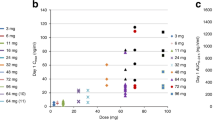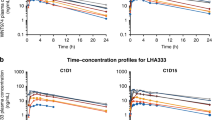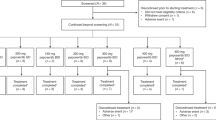Abstract
Reversible alopecia is a commonly observed, important and distressing complication of chemotherapy. Permanent alopecia, however, is rare after standard-dose therapy, but has occasionally been observed after high-dose chemotherapy with cyclophosphamide, thiotepa and carboplatin (CTC). We evaluated the relationships between total exposure to these three compounds and their different metabolites in the high-dose CTC regimen, and the subsequent development of irreversible alopecia. Twenty-four patients received two or three courses of high-dose CTC, each followed by peripheral blood progenitor cell transplantation. Plasma levels of cyclophosphamide, its active metabolite 4-hydroxycyclophosphamide, thiotepa, its active metabolite tepa, and carboplatin were determined, and the area-under-the-plasma concentration-versus-time curves (AUC) of the compounds were calculated. Eight of the 24 patients included in the study developed permanent alopecia, while seven had normal hair regrowth and nine patients developed incomplete and/or thin hair regrowth. The carboplatin AUC and the summed AUC of thiotepa and tepa were both significantly associated with increasing irreversibility of hair loss. These results suggest that high exposure to carboplatin and the sum of the thiotepa and tepa exposure may lead to the development of permanent alopecia. This knowledge could guide therapeutic drug monitoring in order to prevent the occurrence of permanent alopecia and thereby improve the patients’ quality of life.
This is a preview of subscription content, access via your institution
Access options
Subscribe to this journal
Receive 12 print issues and online access
$259.00 per year
only $21.58 per issue
Buy this article
- Purchase on Springer Link
- Instant access to full article PDF
Prices may be subject to local taxes which are calculated during checkout
Similar content being viewed by others
References
Coates A, Abraham S, Kaye SB et al. On the receiving end – patient perception of the side-effects of cancer chemotherapy Eur J Cancer Clin Oncol 1983 19: 203 208
Welch D, Lewis K . Alopecia and chemotherapy Am J Nurs 1980 80: 903 905
Koppel RA, Boh EE . Cutaneous reactions to chemotherapeutic agents Am J Med Sci 2001 321: 327 335
Hussein M . Chemotherapy-induced alopecia: new developments South Med J 1993 86: 489 496
Shirai A, Tsunoda H, Tamaoki T, Kamiya T . Topical application of cyclosporin A induces rapid-remodeling of damaged anagen hair follicles produced in cyclophosphamide administered mice J Derm Sci 2001 27: 7 13
Tran D, Sinclair RD, Schwarer AP, Chow CW . Permanent alopecia following chemotherapy and bone marrow transplantation Aus J Dermatol 2000 41: 106 108
Ljungman P, Hassan M, Békássy AN et al. Busulfan concentration in relation to permanent alopecia in recipients of bone marrow transplants Bone Marrow Transplant 1995 15: 869 871
Baker BW, Wilson CL, Davis AL et al. Busulphan/cyclophosphamide conditioning for bone marrow transplantation may lead to failure of hair re-growth Bone Marrow Transplant 1991 7: 43 47
Vowels M, Chan LL, Giri N et al. Factors affecting hair regrowth after bone marrow transplantation Bone Marrow Transplant 1993 12: 347 350
Rodenhuis S, Baars JW, Schornagel JH et al. Feasibility and toxicity study of a high-dose chemotherapy regimen for autotransplantation incorporating carboplatin, cyclophosphamide and thiotepa Ann Oncol 1992 3: 855 860
Rodenhuis S, Richel DJ, Van Der Wall E et al. Randomised trial of high-dose chemotherapy and haemopoietic progenitor-cell support in operable breast cancer with extensive axillary lymph-node involvement Lancet 1998 352: 515 521
Rodenhuis S, Westerman A, Holtkamp MJ et al. Feasibility of multiple courses of high-dose cyclophosphamide, thiotepa, and carboplatin for breast cancer or germ cell cancer J Clin Oncol 1996 14: 1473 1483
Rodenhuis S, De Wit R, De Mulder PHM et al. A multi-center prospective phase II study of high-dose chemotherapy in germ-cell cancer patients relapsing from complete remission Ann Oncol 1999 10: 1467 1473
Calvert AH, Newell DR, Gumbrell LA et al. Carboplatin dosage: prospective evaluation of a simple formula based on renal function J Clin Oncol 1989 7: 1748 1756
Huitema ADR, Spaander M, Mathôt RAA et al. Relationship between exposure and toxicity in high-dose chemotherapy with cyclophosphamide, thioTEPA and carboplatin Ann Oncol 2002 13: 374 384
Beal SL, Sheiner LB . User's Guides NONMEM Project Group, University of California at San Francisco, San Francisco 1998
Cash TF . The psychosocial consequences of androgenic alopecia: a review of the research literature Br J Dermatol 1999 144: 398 405
Tierney A, Taylor J, Closs SJ et al. Hair loss due to cytotoxic chemotherapy: a prospective descriptive study Br J Cancer 1990 62: 527 528
Katsimbri P, Bamias A, Pavlidis N . Prevention of chemotherapy-induced alopecia using an effective scalp cooling system Eur J Cancer 2000 36: 766 771
Paus R, Handjiski B, Eichmuller S, Czarnetzki BM . Chemotherapy-induced alopecia in mice. Induction by cyclophosphamide, inhibition by cyclosporin A, and modulation by dexamethasone Am J Pathol 1994 144: 719 734
Hussein AM, Stuart A, Peters WP . Protection against chemotherapy-induced alopecia by cyclosporin A in the newborn rat animal model Dermatology 1995 190: 192 196
Chen G, Baechle A, Nevins TD et al. Protection against cyclophosphamide-induced alopecia and inhibition of mammary tumor growth by topical 1,25-dihydroxyvitamin D3 in mice Int J Cancer 1998 75: 303 309
Hidalgo M, Rinaldi D, Medina G et al. A phase I trial of topical topitriol (calcitriol, 1,25-dihydroxyvitamin D3) to prevent chemotherapy-induced alopecia Anti-Cancer Drugs 1999 10: 393 395
Paus R, Schilli MB, Handjiski B et al. Topical calcitriol enhances normal hair regrowth but does not prevent chemotherapy-induced alopecia in mice Cancer Res 1996 56: 4438 4443
Jimenez JJ, Yunis AA . Protection from chemotherapy-induced alopecia by 1,25-dihydroxyvitamin D3 Cancer Res 1992 52: 5123 5125
Peters EM, Foitzik K, Paus R et al. A new strategy for modulating chemotherapy-induced alopecia, using PTH/PTHrP receptor agonist and antagonist J Invest Dermatol 2001 117: 173 178
Van Den Bongard HJGD, Mathôt RAA, Beijnen JH, Schellens JHM . Pharmacokinetically guided administration of chemotherapeutic agents Clin Pharmacokinet 2000 39: 345 367
Van Maanen MJ, Smeets CJM, Beijnen JH . Chemistry, pharmacology and pharmacokinetics of N,N′,N″-triethylenethiophosphoramide (thiotepa) Cancer Treat Rev 2000 26: 257 268
Moore MJ . Clinical pharmacokinetics of cyclophosphamide Clin Pharmacokinet 1991 20: 194 208
Ayash LJ, Wright JE, Tretyakov O et al. Cyclophosphamide pharmacokinetics: correlation with cardiac toxicity and tumor response J Clin Oncol 1992 10: 995 1000
Ten Bokkel Huinink WW, Dercksen MW, Van Tinteren H . Further studies to ameliorate toxicity of carboplatin Semin Oncol 1994 21: 27 33
Rodenhuis S . The status of high-dose chemotherapy in breast cancer The Oncologist 2000 5: 369 375
Acknowledgements
This research was supported with a grant from the Dutch Cancer Society (project NKI 2001-2420).
Author information
Authors and Affiliations
Rights and permissions
About this article
Cite this article
de Jonge, M., Mathôt, R., Dalesio, O. et al. Relationship between irreversible alopecia and exposure to cyclophosphamide, thiotepa and carboplatin (CTC) in high-dose chemotherapy. Bone Marrow Transplant 30, 593–597 (2002). https://doi.org/10.1038/sj.bmt.1703695
Received:
Accepted:
Published:
Issue Date:
DOI: https://doi.org/10.1038/sj.bmt.1703695
Keywords
This article is cited by
-
High dose craniospinal irradiation as independent risk factor of permanent alopecia in childhood medulloblastoma survivors: cohort study and literature review
Journal of Neuro-Oncology (2022)
-
Alopecia in Association with Malignancy: A Review
American Journal of Clinical Dermatology (2018)
-
Permanent diffuse alopecia after haematopoietic stem cell transplantation in childhood
Bone Marrow Transplantation (2017)
-
Six cases of permanent alopecia after various conditioning regimens commonly used in hematopoietic stem cell transplantation
Bone Marrow Transplantation (2007)



